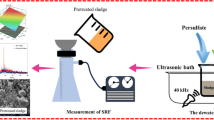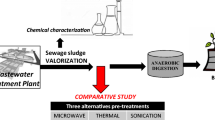Abstract
In this study, the dewaterability characteristics of electroplating sludge have been investigated after treatment with microwave irradiation. While specific resistance to filtration (SRF) was used to evaluate sludge dewaterability, water content (WC) in sludge and soluble chemical oxygen demand (SCOD) were determined to describe the observed changes in sludge dewaterability. SRF of sludge decreased from 3.54E + 09 m/kg to 4.33E + 08 m/kg, and WC decreased from 98.56 wt.% to 94.37 wt.% after microwave treatment at 800 W and 120 s. Sludge solubilization increased with microwave power, but deteriorated at higher contact times due to adverse effects of sustained microwave irradiation. A full factorial design along with response surface analysis was applied to determine an optimum combination of microwave power and contact time for effective dewaterability enhancement. Based on statistical observations and numerical optimization using desirability function analysis, 800 W and 141 s was the optimal conditioning requirement which yielded minimum SRF and WC, while also ensuring maximum sludge disintegration.









Similar content being viewed by others
References
Upadhyay K (2006) Solution for wastewater problem related to electroplating industry. J Ind Pollut Control 22:59–66
Duncan JB, Guthrie MD, Lueck KJ, Avila M (2007) Laboratory study for the reduction of chrome (VI) to chrome (III) using sodium metabisulfite under acidic conditions. US Department of Energy, Richland
Ademiluyi FT, Amadi SA, Amakama JN (2009) Adsorption and treatment of organic contaminants using activated carbon from waste nigerian bamboo. J Appl Sci Environ Manag 13:39–47
Chen D, Mei CY, Yao LH, Jin HM, Qian GR, Zhu ZP (2011) Flash fixation of heavy metals from two industrial wastes into ferrite by microwave hydrothermal co-treatment. J Hazard Mater 192:1675–1682
Ministry of Environment, Forest and Climate Change (2016) Hazardous and Other Wastes (Management and Transboundary Movement) Rules, 2016. Ministry of Environment Forest and Climate Change, Government of India, New Delhi
Chen CL, Lo SL, Kuan WH, Hsieh CH (2005) Stabilization of Cu in acid-extracted industrial sludge using a microwave process. J Hazard Mater B123:256–261
Liu H, Yang J, Shi Y, Li Y, He S, Yang C, Yao H (2012) Conditioning of sewage sludge by Fenton’s reagent combined with skeleton builders. Chemosphere 88:235–239
Mo R, Huang S, Dai W, Liang J, Sun S (2015) A rapid Fenton treatment technique for sewage sludge dewatering. Chem Eng J 269:391–398
Yuan H, Cheng X, Chen S, Zhu N, Zhou Z (2011) New sludge pretreatment method to improve dewaterability of waste activated sludge. Bioresour Technol 102:5959–5964
Ruiz-Hernando M, Martinez-Elorza G, Labanda J, Llorens J (2013) Dewaterability of sewage sludge by ultrasonic, thermal and chemical treatments. Chem Eng J 230:102–110
Feng X, Deng J, Lei H, Bai T, Fan Q, Li Z (2009) Dewaterability of waste activated sludge with ultrasound conditioning. Bioresour Technol 100:1074–1081
Zhu C, Zhang P, Wang H, Ye J (2018) Conditioning of sewage sludge via combined ultrasonication-flocculation-skeleton building to improve sludge dewaterability. Ultrason Sonochemistry 40:353–360
Saha M, Eskicioglu C, Marin J (2011) Microwave, ultrasonic and chemo-mechanical pretreatments for enhancing methane potential of pulp mill wastewater treatment sludge. Bioresour Technol 102:7815–7826
Yu Q, Lei H, Yu G, Feng X, Li Z, Wu Z (2009) Influence of microwave irradiation on sludge dewaterability. Chem Eng J 155:88–93
Yu Q, Lei H, Li Z, Li H, Chen K, Zhang X, Liang R (2010) Physical and chemical properties of waste-activated sludge after microwave treatment. Water Res 44:2841–2849
Feng X, Lei H, Deng J, Yu Q, Li H (2009) Physical and Chemical characteristics of waste activated sludge treated ultrasonically. Chem Eng Process 48:187–194
Gan Q (2000) A case study of microwave processing of metal hydroxide sediment sludge from printed circuit board manufacturing wash water. Waste Manag 20:695–701
Beszedes S, Laszlo Z, Horvath ZH, Szabo G, Hodur C (2011) Comparison of the effects of microwave irradiation with different intensities on the biodegradability of sludge from the dairy- and meat-industry. Bioresour Technol 102:814–821
Rani RU, Kumar SA, Kaliappan S, Yeom I, Banu JR (2013) Impacts of microwave pretreatments on the semi-continuous anaerobic digestion of waste activated sludge. Waste Manag 33:1119–1127
American Public Health Association (APHA) (1998) Standard methods for the examination of water and wastewater, 20th edn. American Public Health Association, Washington
Lo IMC, Lai KCK, Chen GH (2001) Salinity effect on mechanical dewatering of sludge with and without chemical conditioning. Environ Sci Technol 35:4691–4696
Huan L, Yiying J, Mahar RB, Zhiyu W, Yongfeng N (2009) Effects of ultrasonic disintegration on sludge microbial activity and dewaterability. J Hazard Mater 161:1421–1426
Montgomery DC (2013) Design and analysis of experiments, 8th edn. John Wiley and Sons Inc., Hoboken
Edgar TF, Himmelblau DM, Lasdon L (2001) Optimization of chemical processes, 2nd edn. McGraw-Hill, New York
Yin X, Lu X, Han P, Wang Y (2006) Ultrasonic treatment on activated sewage sludge from petro-plant for reduction. Ultrasonics 44:e397–e399
Kopp J, Dichtl N (2001) Influence of the free water content on the dewaterability of sewage sludges. Water Sci Technol 44:177–183
Kiely G (2007) Environmental engineering. Tata McGraw-Hill Publishing Company Limited, New Delhi
Seehra MS, Kalra A, Manivannan A (2007) Dewatering of fine coal slurries by selective heating with microwaves. Fuel 86:829–834
Wojciechowska E (2005) Application of microwaves for sewage sludge conditioning. Water Res 39:4749–4754
Tyagi VK, Lo SL (2013) Microwave irradiation: a sustainable way for sludge treatment and resource recovery. Renew Sustain Energy Rev 18:288–305
Hsieh CH, Lo SL, Kuan WH, Chen CL (2006) Adsorption of copper ions onto microwave stabilized heavy metal sludge. J Hazard Mater B136:338–344
Acknowledgement
The authors are highly thankful to Er. Suhail Ahmad Siddiqui for the assistance with experimental setup, and Prof. Anwar Khursheed and Prof. Sadaf Zaidi for sharing their valuable technical expertise. The authors acknowledge the support of technical staff of Department of Chemical Engineering, Aligarh Muslim University for provision of laboratory support during this research. Finally, thanks are due to the staff of lock industry at Aligarh for experimental assistance.
Funding
This research did not receive any specific grant from funding agencies in the public, commercial, or not-for-profit sectors.
Author information
Authors and Affiliations
Corresponding author
Ethics declarations
Conflict of interest
The authors declare that they have no conflict of interest.
Additional information
Publisher's Note
Springer Nature remains neutral with regard to jurisdictional claims in published maps and institutional affiliations.
Rights and permissions
About this article
Cite this article
Faruqi, M.H.Z., Siddiqui, F.Z. & Hassan, S.Z. Optimization of microwave treatment for dewaterability enhancement of electroplating sludge. J Mater Cycles Waste Manag 23, 566–580 (2021). https://doi.org/10.1007/s10163-020-01141-z
Received:
Accepted:
Published:
Issue Date:
DOI: https://doi.org/10.1007/s10163-020-01141-z




